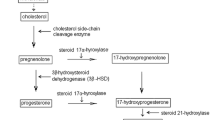Abstract
(1) The effect of twice-daily meals on a body weight (BW) and blood pressure (BP), (2) the effect of working night shifts on BPs, and (3) a relationship between a meat diet and cedar pollinosis were statistically investigated with working men who had an annual medical examination. As a result, the effect of twice-daily meals on BW and BP was not different from thrice-daily meals on BW and BP. However, cases of twice-daily meals had larger percentages of alcohol drinkers and cigarette smokers. The night shift workers had almost the same frequency of hypertension as compared with day duty workers. A daily diet of meat including beef, chicken, and pork had a close relationship with cedar pollinosis.
Similar content being viewed by others
References
Nagamine, S., Physiology of obesity. (S. Suzuki and S. Nomura eds.),Life and Obesity (Jap), Ishiyaku-Shuppan, Tokyo, pp. 45–47, 1985.
Yamazaki, F.,Cedar Pollinosis (Jap), Iyaku-Journal, Tokyo, pp. 95–105, 1991.
Ohsaka, F., Kasuga, H., Sugita, M., Matumoto, H., A study on the relationship between Japanese cedar IgE in serum and housing environment in school children (Jap),Allergy, 36[2]:72–80, 1987.
Nomura, K., Uchikoshi, S., Komatu, N., Mikuni, I., Life environment of patients with Japanese cedar pollinosis.Otolaryngology 53[9]:667–672, 1981.
Baumgart, P., Walger, P., Fuchs, G., Eiff, M., Vetter, H., Rahn, H.K., Diurnal variations of blood pressure in shift workers during day and night shifts.Int. Arch. Occup. Environ. Health 61:463–466, 1989.
Fouriaud, C., Jaquinet-Salord, M.C., Degoulet, P., Aime, F., Lang, T., Laprugne, J., Main, J., Oeconomos, J., Phalente, J., Prades, A., Influence of socioprofessional conditions on blood pressure levels and hypertension control.Am. J. Epidemiol. 120:72–86, 1984.
Young, M.C., Hutter, F.L., Scanlan, S.S., Rand, E.C., Lutwak, L., Simko, V., Metabolic effects of meal frequency on normal young men.J. Am. Dietet. A,61:391–398, 1972.
Sundberg, S., Kohvakka, A., Gordin, A., Rapid reversal of circadian blood pressure rhythm in shift workers.J. Hyperten. 6:393–396, 1988.
Chau, P.N., Mallion, M.J., Gaudemaris, R., Ruche, E., Siche, P.J., Pelen, O., Mathern, G., Twenty-four-hour ambulatory blood pressure in shift workers.Circulation 80[2]:341–347, 1989.
Kornhuber, H.H., Lisson, G., Bluthochdruck sind Industrie-Stressoren, Larm order Akkordarbeit wichtige Ursachen?Dtsh. Med. Wochenschr. 106:1733–1736, 1981.
Nihon-Keizai Newspaper Publisher: A Guide to Japanese Economy (Jan), Nihon-Keizai Publisher, Tokyo, p. 100, 1991.
Statistic Bureau of the Prime Minister's Office: Yearly amount of expenditures by commodities per household. Statistics Bureau of the Prime Minister Office, Tokyo, pp. 104–105, 1961, pp. 398–399, 1970.
Author information
Authors and Affiliations
Rights and permissions
About this article
Cite this article
Ishizuka, T., Furuya, Y. Influence of meals and night shifts on health. J Med Syst 17, 201–206 (1993). https://doi.org/10.1007/BF00996946
Issue Date:
DOI: https://doi.org/10.1007/BF00996946




